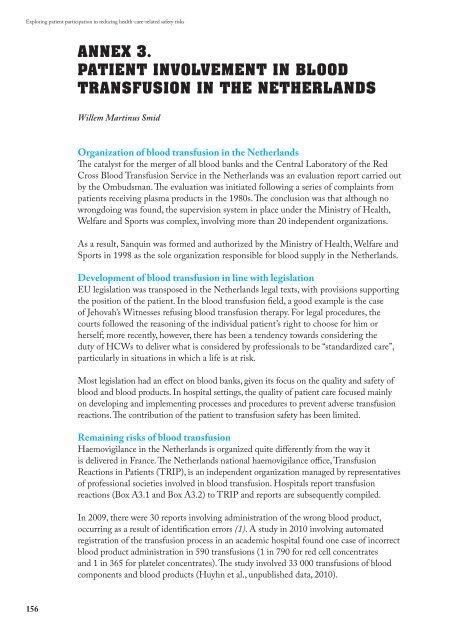Exploring patient participation in reducing health-care-related safety risks
Exploring patient participation in reducing health-care-related safety risks
Exploring patient participation in reducing health-care-related safety risks
You also want an ePaper? Increase the reach of your titles
YUMPU automatically turns print PDFs into web optimized ePapers that Google loves.
<strong>Explor<strong>in</strong>g</strong> <strong>patient</strong> <strong>participation</strong> <strong>in</strong> reduc<strong>in</strong>g <strong>health</strong>-<strong>care</strong>-<strong>related</strong> <strong>safety</strong> <strong>risks</strong><br />
156<br />
ANNEX 3.<br />
pATIENT INVOLVEMENT IN BLOOD<br />
TRANSFUSION IN ThE NEThERLANDS<br />
Willem Mart<strong>in</strong>us Smid<br />
Organization of blood transfusion <strong>in</strong> the Netherlands<br />
The catalyst for the merger of all blood banks and the Central Laboratory of the Red<br />
Cross Blood Transfusion Service <strong>in</strong> the Netherlands was an evaluation report carried out<br />
by the Ombudsman. The evaluation was <strong>in</strong>itiated follow<strong>in</strong>g a series of compla<strong>in</strong>ts from<br />
<strong>patient</strong>s receiv<strong>in</strong>g plasma products <strong>in</strong> the 1980s. The conclusion was that although no<br />
wrongdo<strong>in</strong>g was found, the supervision system <strong>in</strong> place under the M<strong>in</strong>istry of Health,<br />
Welfare and Sports was complex, <strong>in</strong>volv<strong>in</strong>g more than 20 <strong>in</strong>dependent organizations.<br />
As a result, Sanqu<strong>in</strong> was formed and authorized by the M<strong>in</strong>istry of Health, Welfare and<br />
Sports <strong>in</strong> 1998 as the sole organization responsible for blood supply <strong>in</strong> the Netherlands.<br />
Development of blood transfusion <strong>in</strong> l<strong>in</strong>e with legislation<br />
EU legislation was transposed <strong>in</strong> the Netherlands legal texts, with provisions support<strong>in</strong>g<br />
the position of the <strong>patient</strong>. In the blood transfusion field, a good example is the case<br />
of Jehovah’s Witnesses refus<strong>in</strong>g blood transfusion therapy. For legal procedures, the<br />
courts followed the reason<strong>in</strong>g of the <strong>in</strong>dividual <strong>patient</strong>’s right to choose for him or<br />
herself; more recently, however, there has been a tendency towards consider<strong>in</strong>g the<br />
duty of HCWs to deliver what is considered by professionals to be “standardized <strong>care</strong>”,<br />
particularly <strong>in</strong> situations <strong>in</strong> which a life is at risk.<br />
Most legislation had an effect on blood banks, given its focus on the quality and <strong>safety</strong> of<br />
blood and blood products. In hospital sett<strong>in</strong>gs, the quality of <strong>patient</strong> <strong>care</strong> focused ma<strong>in</strong>ly<br />
on develop<strong>in</strong>g and implement<strong>in</strong>g processes and procedures to prevent adverse transfusion<br />
reactions. The contribution of the <strong>patient</strong> to transfusion <strong>safety</strong> has been limited.<br />
Rema<strong>in</strong><strong>in</strong>g <strong>risks</strong> of blood transfusion<br />
Haemovigilance <strong>in</strong> the Netherlands is organized quite differently from the way it<br />
is delivered <strong>in</strong> France. The Netherlands national haemovigilance office, Transfusion<br />
Reactions <strong>in</strong> Patients (TRIP), is an <strong>in</strong>dependent organization managed by representatives<br />
of professional societies <strong>in</strong>volved <strong>in</strong> blood transfusion. Hospitals report transfusion<br />
reactions (Box A3.1 and Box A3.2) to TRIP and reports are subsequently compiled.<br />
In 2009, there were 30 reports <strong>in</strong>volv<strong>in</strong>g adm<strong>in</strong>istration of the wrong blood product,<br />
occurr<strong>in</strong>g as a result of identification errors (1). A study <strong>in</strong> 2010 <strong>in</strong>volv<strong>in</strong>g automated<br />
registration of the transfusion process <strong>in</strong> an academic hospital found one case of <strong>in</strong>correct<br />
blood product adm<strong>in</strong>istration <strong>in</strong> 590 transfusions (1 <strong>in</strong> 790 for red cell concentrates<br />
and 1 <strong>in</strong> 365 for platelet concentrates). The study <strong>in</strong>volved 33 000 transfusions of blood<br />
components and blood products (Huyhn et al., unpublished data, 2010).



